Single-setting phaco decreases the risk of tissue damage during cataract surgery
Dual-linear control of phaco power and aspiration makes a single-setting technique possible.
September 2000
Most phacoemulsification techniques require two or more settings. Each setting is specific for one stage of the phaco surgery. With the introduction of phaco machines capapble of dual linear control, a single setting phaco technique becomes possible. Aspiration rate and phaco power can be set to a specific range and controlled through the foot pedal. This opens your surgical control to a different dimension, going from your usual “phaco 1” setting to “phaco 2” or from “phaco 3” to the “phaco 2” setting any time the need for it arises “at a touch of your foot.”
The technique described here is an attempt to simplify the countless methods being used today by cataract surgeons worldwide. It takes bits and pieces from these techniques, eliminating parts that are not effective and resulting in a simpler technique.
In my single-setting technique I use a Nagahara chopper for my second instrument. I prefer this because of its long cutting tip and rounded end. I use a 2.5-mm phaco tip with a 15° port. This technique is basically a modification of the one described by Nagahara.
On my dual linear phaco machine, aspiration is set at 200 mm Hg and phaco power at 20%. Phaco power is set with a 5 per second pulse and a minimum phaco power of 5%. Bottle height is 60 cm. Aspiration is used predominantly in this technique and phaco power is used sparingly, decreasing the risk of damage to tissues by ultrasound. Pulse mode not only facilitates emulsification, but also decreases the phaco power and phaco time needed to emulsify the lens material.
Less than 20% of the aspiration is used in most applications. An aspiration rate of more than 20% will collapse the anterior chamber if used without occlusion. Higher aspiration is applied only when there is occlusion, to increase holding capacity. Phaco is then applied with just enough power to emulsify a particular piece of lens material or when occlusion is achieved. Using too much phaco power will only bounce the lens material, thereby loosening your hold and increasing the risk of tissue damage from the ultrasound and/or from the mechanical touch of the lens material to the endothelium. Aspiration and phaco power are slowly withdrawn as the lens material is aspirated.
Surgical technique
Incision, capsulorrhexis and hydrodissection are done in the usual fashion. The phaco tip is inserted and the anterior cortex and the epinucleus is “shaved,” exposing the anterior nucleus using just enough aspiration (Figure 1). No phaco power is used unless there is occlusion or no effective aspiration is observed. (It is a good practice to test your phaco tip before inserting it into the eye.)
The second instrument is then inserted and the phaco tip is buried into the adjacent nucleus equator. Increasing aspiration is applied as the tip buries itself into the nucleus. Minimal phaco power is used to create a tight tunnel. Too much power will result in a loose tunnel prone to aspiration leak, thereby decreasing hold. The tip is driven past the center of the nucleus using the tip of the probe as a guide to the depth of the tunnel (Figure 2).
Once this is achieved, phaco power is withdrawn and a high aspiration rate is maintained to hold the nuclear material. The chopper is inserted at the opposite nuclear equator and brought toward the phaco tip, dividing the nucleus in two. This is completed by separating the two halves further by moving the two instruments away from each other (Figure 3).
The phaco tip is buried into the adjacent nucleus until a firm hold is achieved, again using low phaco power and an adequately high aspiration rate to hold the nuclear material. The chopper is inserted at the opposite equator and brought to the tip of the phaco probe. Chopping this segment from one half (Figure 4) creates a slice of “pie.” This is then emulsified and aspirated (Figure 5). The same procedure is done to the other half of the nucleus (Figure 6). The remaining nuclear material is chopped and aspirated using similar parameters and the same principle (Figure 7). Aspiration of the first pie slice will give you more room to do your maneuvers more freely. This procedure becomes easier as the lens material decreases in mass and the space increases.
The epinucleus may be aspirated easily with the phaco tip (Figure 8), which has a larger port, or a regular irrigation and aspiration cannula. The cortex is aspirated in the usual fashion and the posterior chamber lens is implanted.
Minimal phaco power is usually all that is required. Aspiration is the predominant mode used in this technique. Phaco power is used only when occlusion is achieved or no effective aspiration is noted. Pulse mode facilitates emulsification of the lens material at the same time, lowering the use of your phaco power and shortening your phaco time. The lens material is aspirated as it is fragmented. This way, the chance of mechanical trauma from the “flying” lens fragments is minimized. This also will give you more “working space” as you go along. With this technique, you can limit your phaco time to below 1 minute and your phaco power to less than 10%.
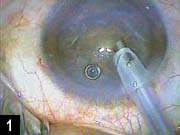 |
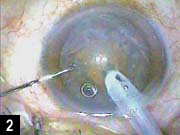 |
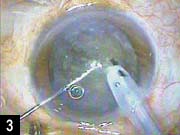 |
| Shaving of the anterior cortical material and anterior epinucleus is performed. | Phaco probe is buried into the nuclear substance using high aspiration and low phaco power. | Nucleus is divided in half with the Nagahara chopper. |
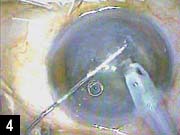 |
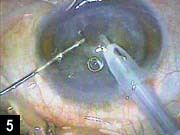 |
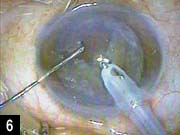 |
| Phaco probe is buried into the adjacent half and the first “slice of pie” is chopped. | First slice of pie is aspirated. | The phaco probe is buried into the other half and second slice is chopped and aspirated. |
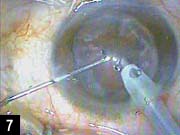 |
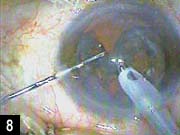 |
|
| The remaining nuclear material is chopped and aspirated. | Epinucleus is aspirated. |
For Your Information:
- Victor B. Lopez, MD, can be reached at Makati Medical Center, 2 Amorsolo St., Ste. 242, Makati City, Philippines; +(63) 2-892-9619; fax: +(63) 2-893-4367.
